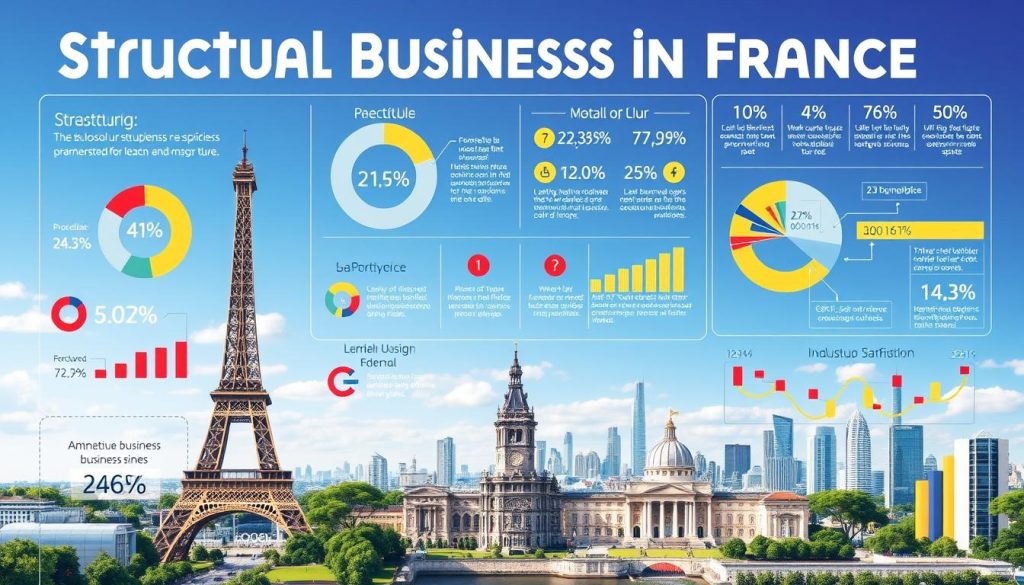In the world of economic analysis, structural business statistics in France are key. They help us understand the wide range of businesses. By looking at business data, we learn a lot about how businesses work, what they are like, and what they contribute to the economy.
This knowledge is crucial for those who make policies and for businesses and researchers. They use it to make smart choices and decisions.
Looking into the beginnings, ways, and effects of enterprise statistics, we see how they change our view of the business world. We find out about the detailed ways data is collected. And we see how these statistics influence decisions in many areas of France.
Overview of Structural Business Statistics in France
Understanding the Definition of SBS is key to seeing the big picture of business statistics in France. These stats track the structure and performance of businesses. They also help with economic analysis. This shows how vital business statistics are.
Definition and Importance of SBS
The Definition of SBS covers the data on businesses in the French economy. It has many roles, like:
- Tracking changes in the business world
- Helping policymakers make economic plans
- Assessing how rules affect businesses
We see how crucial business statistics are. They help make smart choices that support entrepreneurship and the economy.
Historical Context and Evolution of Data Collection
The history of SBS is rich, starting with early data collection. It aimed to understand business behaviour and its impact. The Annual Business Surveys (EAE) and Unified Corporate Statistics System (Suse) were big steps forward.
Before 2009, these systems were the main way to collect data. Now, combining administrative data with surveys has made the statistics more accurate and useful. This helps us understand business health and growth in different areas.
The ESANE Scheme and Its Impact on Business Statistics
The ESANE Scheme was introduced in 2009, changing the way we collect business data in France. It merged the EAE and Suse systems, making data collection more unified and efficient. This has made our business statistics more accurate and reliable, giving us a better understanding of the French business world.
Introduction of the ESANE Scheme
The ESANE Scheme is a key part of our data collection reform. It has made gathering data easier and more efficient. This means we can now analyze the business environment more thoroughly, getting data that is both timely and relevant.
Benefits of Reduced Questionnaire Burden
One big advantage of the ESANE Scheme is the Reduced questionnaire burden on businesses. By cutting the data requests in half, we’ve seen a big jump in response rates. This makes it easier for businesses to participate, giving us more data to work with.
With better response rates, our data quality has improved. We can now respond quickly to market changes, making decisions based on solid data. The ESANE Scheme has made our business statistics better and more efficient.

Key Indicators in Structural Business Statistics in France
Looking into the enterprise population in France gives us important insights. With over 5.2 million active enterprises in 2022, we see the variety in the business world. Trends show how these businesses affect jobs, productivity, and different sectors.
Enterprise Population and Characteristics
In France, many small and medium-sized enterprises (SMEs) are key to the economy. They help grow the economy and create jobs. These businesses are a big part of the workforce, showing the importance of their size and what they do.
Sectoral Analysis: Distribution of Enterprises
The way businesses are spread across sectors is also important. The service sector leads, with over 80% of all businesses. Professional services, retail, and construction are growing fast. Even though manufacturing is smaller, it’s crucial for the economy’s value.

Structural Business Statistics in France: Employment Trends
It’s crucial to understand the employment trends in France’s sectors. This helps us see how the workforce is spread out and the state of the economy. We find out how small and medium-sized enterprises (SMEs) play a big role in our society.
Workforce Distribution Across Sectors
In France, the workforce is not evenly spread across sectors. The services sector has about 78% of the active workforce. It’s a key part of the economy, making up 70.7% of the GDP. On the other hand, the industrial sector has 19.5% of the workforce, and agriculture has just 2.5%.
The services sector is not just big in numbers; it’s also growing fast. It sees an annual increase of 3.7% in value added. This shows the sector’s strength and potential for more growth.
Despite stable wages, unemployment in France remains at 7.4% for a year. Young people face even higher unemployment, going from 16.9% to 17.9% in a year. It’s important for policymakers to tackle these issues to improve employment and workforce distribution.
Role of Small and Medium-Sized Enterprises (SMEs)
SMEs are key to our economy, employing about two-thirds of the workforce. They add more than 50% of the value to the business economy. Their ability to adapt and innovate is crucial for creating jobs and driving growth.
SMEs are at the heart of job creation, especially in local markets. They help keep the economy strong by contributing to various sectors. This data highlights the importance of SMEs in maintaining employment and facing economic challenges.
Economic Contributions of Enterprises in France
It’s key to understand how businesses help the French economy. Each sector adds value, showing how well businesses are doing. The latest numbers show the services sector is big, with lots of businesses and jobs, making a big impact on money.
Value Added by Different Sectors
The services sector stands out, with 80.4% of all businesses and over two-thirds of jobs. It created about 3.7 million jobs in 2022, showing its importance. Looking at each industry helps us see how well the economy is doing.
Investment Trends and Economic Performance
Investment trends show where businesses put their money, showing confidence in their future. By watching these trends, we see how businesses react to changes. This helps us find areas for growth, helping everyone plan better.

